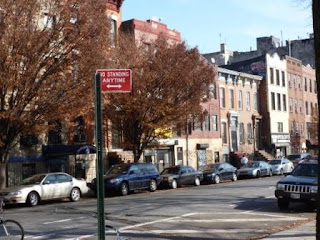Tonight I took a slightly different route home from the ones I normally take. Part of the reason I did that was to avoid a very snarled intersection I pedaled through on my way in. (Why do they call them "construction" projects when they're tearing things apart?) Also, I wanted a bit of variety to shake myself out of my doldrums, as I've been a bit "under the weather" for the past couple of days.
So, from being under a blanket of flannel, I pedaled into a developing blanket of fog.
Plenty of cyclists, including yours truly, have talked and written about cycling in rain, snow and any number of other weather conditions. But I can't recall the last time I heard or read any mention of fog. I guess there isn't much in particular you can do about it. You don't really need your foul-weather gear, but lights and other high-visibility accessories are a good idea.
I rather enjoy cycling in fog, especially when it builds, as it did on my way home tonight. And, no, I'm not phased by cemeteries: I'm respectful of the dead, and they haven't done anything terrible to me. On two different bike tours I actually slept in cemeteries. I cleaned up after myself before leaving, which may be another reason why I have good karma, or whatever you want to call it, in necropoli. But I digress...
What's interesting about fog is that it develops more subtly than other kinds of weather. Stopping to watch it won't let you see how it gathers or creeps across the land. At some point, you just notice it, like some image that's developed on a screen before your eyes, but at the same time hidden in plain sight. In fact, sometimes you feel the moisture against your face before you see anything. Or, you feel, as I did, what seems to be a drop in the temperature. It felt about ten degrees colder by the time I got home than it did when I started although, according to weather reports, the temperature remained constant at 54F (12C), which is rather mild for this time of year.
Most of the drivers were also going home. Some of their cars turned their lights on automatically, so I wonder just how much, if at all, they noticed the fog developing.
Now I'll leave you with my favorite literary depiction of fog, from one of my favorite poems:
The yellow fog that rubs its back on the window-panes
The yellow smoke that rubs its muzzle on the window-panes
Licked its tongue into the corners of the evening
Lingered upon the pools that stand in drains
Let fall upon its back the soot that falls from chimneys
Slipped by the terrace, made a sudden leap
And seeing that it was a soft October night
Curled once about the house, and fell asleep.
(From "The Love Song Of J.Alfred Prufrock" by T.S. Eliot)
Plenty of cyclists, including yours truly, have talked and written about cycling in rain, snow and any number of other weather conditions. But I can't recall the last time I heard or read any mention of fog. I guess there isn't much in particular you can do about it. You don't really need your foul-weather gear, but lights and other high-visibility accessories are a good idea.
I rather enjoy cycling in fog, especially when it builds, as it did on my way home tonight. And, no, I'm not phased by cemeteries: I'm respectful of the dead, and they haven't done anything terrible to me. On two different bike tours I actually slept in cemeteries. I cleaned up after myself before leaving, which may be another reason why I have good karma, or whatever you want to call it, in necropoli. But I digress...
What's interesting about fog is that it develops more subtly than other kinds of weather. Stopping to watch it won't let you see how it gathers or creeps across the land. At some point, you just notice it, like some image that's developed on a screen before your eyes, but at the same time hidden in plain sight. In fact, sometimes you feel the moisture against your face before you see anything. Or, you feel, as I did, what seems to be a drop in the temperature. It felt about ten degrees colder by the time I got home than it did when I started although, according to weather reports, the temperature remained constant at 54F (12C), which is rather mild for this time of year.
Most of the drivers were also going home. Some of their cars turned their lights on automatically, so I wonder just how much, if at all, they noticed the fog developing.
Now I'll leave you with my favorite literary depiction of fog, from one of my favorite poems:
The yellow fog that rubs its back on the window-panes
The yellow smoke that rubs its muzzle on the window-panes
Licked its tongue into the corners of the evening
Lingered upon the pools that stand in drains
Let fall upon its back the soot that falls from chimneys
Slipped by the terrace, made a sudden leap
And seeing that it was a soft October night
Curled once about the house, and fell asleep.
(From "The Love Song Of J.Alfred Prufrock" by T.S. Eliot)






















